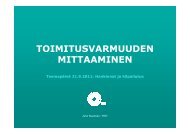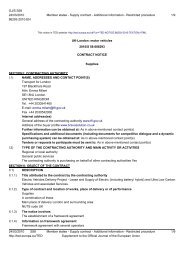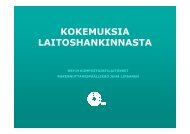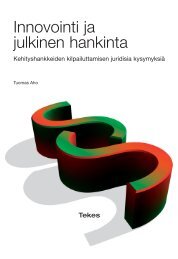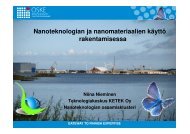Life cycle costing (LCC) as a contribution to sustainable construction ...
Life cycle costing (LCC) as a contribution to sustainable construction ...
Life cycle costing (LCC) as a contribution to sustainable construction ...
Create successful ePaper yourself
Turn your PDF publications into a flip-book with our unique Google optimized e-Paper software.
Towards a common European methodology for <strong>Life</strong> Cycle Costing (<strong>LCC</strong>) – Guidance Document<br />
52<br />
12 Application of <strong>LCC</strong> methodology <strong>to</strong> Museum of World Culture in<br />
Gothenburg in Sweden<br />
Project description<br />
Project title – Museum of World Culture in<br />
Gothenburg, Sweden<br />
Category – Museum building for public sec<strong>to</strong>r –<br />
National Property Board.<br />
General project information – The design by<br />
architects Cecile Brisac and Edgar Gonzalez gives<br />
the Museum of World Culture a robust frame for its<br />
activities. The building h<strong>as</strong> already been awarded<br />
Sweden’s K<strong>as</strong>per Salin Prize for architecture. The<br />
cement and gl<strong>as</strong>s building, located on a slope, is<br />
graceful, compact and modernistic. Its four-s<strong>to</strong>rey<br />
gl<strong>as</strong>s atrium looks out on mountains and woods.<br />
The exhibition halls are in the closed part of the<br />
building. The upper s<strong>to</strong>reys hang five metres<br />
over a footpath. A 43-metre long section of a<br />
display window provides p<strong>as</strong>sers-by with a view<br />
straight in<strong>to</strong> the largest exhibition hall.<br />
The National Property Board’s Role h<strong>as</strong> been <strong>to</strong><br />
manage the entire project, ensure that all of the<br />
museum’s requirements have been fulfilled and<br />
<strong>to</strong> steer the project within the economic<br />
framework allocated by the government.<br />
Exhibition area: 2,600 m 2 , six s<strong>to</strong>reys, five<br />
exhibition halls, research library and offices.<br />
Cost: SEK 305 million<br />
Year of <strong>construction</strong> – 2001-2004 (opened 29 th<br />
December)<br />
Gross internal floor area (GIFA) – 11,000 m 2<br />
Aims and objectives of <strong>LCC</strong> analysis<br />
The main objective w<strong>as</strong> <strong>to</strong> support the design<br />
of the prestigious landmark structure (museum)<br />
with continuous <strong>LCC</strong> calculations of selected<br />
systems b<strong>as</strong>ed on the combination of cost and<br />
their environmental performance. The most<br />
important of the studied systems and some of<br />
the building structures (insulation, windows)<br />
were analysed with <strong>LCC</strong> during the design<br />
stage.<br />
Energy efficient procurement principles b<strong>as</strong>ed<br />
on the ENEU ® concept (Energy Efficient<br />
Procurement) were applied with <strong>LCC</strong> and also<br />
introduced <strong>as</strong> part of the purch<strong>as</strong>ing routines.<br />
Investments with long pay-off time were made profitable<br />
when calculating with ENEU ® concept and <strong>LCC</strong>. On the<br />
museum project HVAC systems cooling and heat pump<br />
systems <strong>as</strong> well <strong>as</strong> circulation pumps were procured using the<br />
ENEU ® concept, which w<strong>as</strong> developed by Bengt Dahlgren AB<br />
in 1994 and <strong>to</strong>day it works almost <strong>as</strong> a standard in Sweden and<br />
also in other Scandinavian countries.<br />
Consultants have carried out environmental reviews<br />
throughout the project, in order <strong>to</strong> guarantee that the<br />
established environmental demands have been followed. The<br />
environmental demands on the project included requirements<br />
for environmental and health reviews of material,<br />
environmentally educated personnel, w<strong>as</strong>te and materials<br />
management, and handling of chemicals. The use of energy is<br />
one of the most important things in these analyses.<br />
Davis Langdon Management Consulting May 2007



